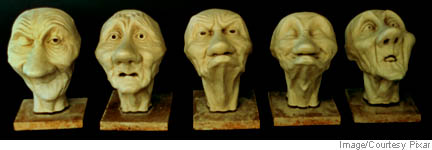Dispatch Movies Made With Math - Feb. 19, 2000
By Mary K. Miller
The name of this AAAS press conference was "Mathematics in the Movies and Everyday Life," which just goes to show that Hollywood now gets top billing over life.

The truth is, according to the mathematicians and computer scientists at the conference, Hollywood needs math more than math needs Hollywood. Without math, there would be no ants in "A Bug's Life," no Buzz Lightyear in "Toy Story," and precious few lawyer-chomping dinosaurs or shipwrecking icebergs in your typical summer blockbuster.

The computer programs used to make the original Toy Story actually used old mathematics, dusted off for a new, completed digitized media form. The first step of the process is to make a clay model of the character, precisely measure its shape, and input the raw data into a computer. The program then creates a shape made of triangles. To look natural, the multi-faceted character needs some smoothing out, accomplished with a mathematical technique known as B-spline.
DeRose and his team were unhappy about the seams so they asked for a project to help them solve the problem. They worked with director Jan Pinkava on a short film called Gheri's Game that revolved around two animated geezers playing a rousing game of chess.
Gheri's story was meant to be an experiment in digital filmmaking, but the results were so good that it leaked out of the virtual laboratory and onto the ant's faces in "A Bug's Life." With the release of Toy Story 2, Buzz's face is now seamless. The digital artists were also able to create Buster, a dog with four million individually created, albeit short, hairs. 
( Download a 5-second sample of the animation -- gheristory.mpg, 120K) Gheri's Story also won an 1997 Academy Award, nice recognition for what DeRose says was set up primarily as a petri dish to do his research. "What makes Pixar unique is our focus on the story," he says. "All the fancy special effects in the world can't save a story that doesn't work." [Return to Main Page]
|
The museum of science, art, and human perception
©2000 The Exploratorium

 Mathematics drives the computer programs that bring animated characters to life, says Tony DeRose, senior scientist at Pixar Studios which produced the hits Toy Story, A Bug's Life, and Toy Story 2. DeRose was a computer science professor at the University of Washington before the animation studio made him an irresistible offer: lead a group of programmers to create memorable characters in the computer.
Mathematics drives the computer programs that bring animated characters to life, says Tony DeRose, senior scientist at Pixar Studios which produced the hits Toy Story, A Bug's Life, and Toy Story 2. DeRose was a computer science professor at the University of Washington before the animation studio made him an irresistible offer: lead a group of programmers to create memorable characters in the computer.
 In Toy Story, Woody's fingers were created with B-splines and if you look closely you can see the shortcomings of this digital technique. To attach Woody's fingers to his palm, the computer splices them together leaving a noticeable seam where they meet. You can also see a seam between Buzz's nose and his face.
In Toy Story, Woody's fingers were created with B-splines and if you look closely you can see the shortcomings of this digital technique. To attach Woody's fingers to his palm, the computer splices them together leaving a noticeable seam where they meet. You can also see a seam between Buzz's nose and his face.
 The hands and facial expressions of the human-like animated characters had to move and look natural, an especially difficult challenge. To meet it, DeRose's team invented a new mathematical tool called subdivision surfacing. In essence, DeRose explains, Gheri and his rival are like digital puppets, computer-created shapes controlled by virtual strings. While a real puppet needs 15-30 strings to make it move, subdivision surfacing provided Gheri with 700 virtual strings.
The hands and facial expressions of the human-like animated characters had to move and look natural, an especially difficult challenge. To meet it, DeRose's team invented a new mathematical tool called subdivision surfacing. In essence, DeRose explains, Gheri and his rival are like digital puppets, computer-created shapes controlled by virtual strings. While a real puppet needs 15-30 strings to make it move, subdivision surfacing provided Gheri with 700 virtual strings.